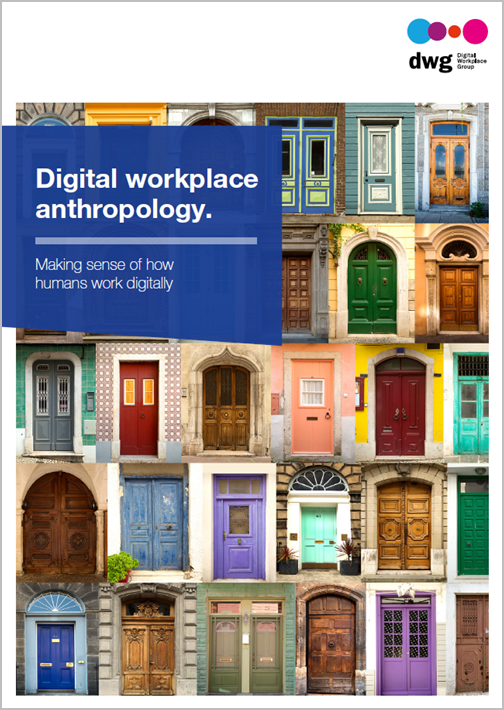Think like an anthropologist to get the best out of your digital workplace

What was once considered the future of work is a present reality for many. Some may have entire teams and organizations working remotely, while other teams and organizations may be experimenting with hybrid work environments. The reality that exists for everyone is that our way of working has fundamentally changed. This change goes deeper than just the technologies powering our daily communication and collaboration. Our symbols, narratives, beliefs, rituals, taboos, economics, power dynamics and daily practices have not only been disrupted, but have experienced or are experiencing a seismic shift.
After almost two years of working in environments influenced by a global pandemic, the way we show up to work – whether this be in a physical environment or a digital workplace – and the ways in which we get work done are being questioned and, sometimes, challenged. Prior to this worldwide reckoning, many teams and organizations claimed a human-centric approach to process and technology design. For some, current events have demonstrated that these processes and their programme design may be efficient and effective but at the same time they dehumanize the very workforce they are meant to benefit.
Our ways of working cannot be limited to what was or what has been; rather, we need a systematic way to see around corners and understand, then anticipate, social, technological, economic, environmental and political drivers and forces of change. We need a fresh take on how to ask good questions, challenge old knowledge and become open to sharing alternative ideas and visions. We need to be able to make sense of what was, what is, and what may be. In the DWG report, Digital workplace anthropology: Making sense of how humans work digitally, we unlock how we may observe, understand and connect disparate spaces with a deeper understanding of human experiences to identify multiple pathways from which organizations may provide a seamless employee experience.
Our ways of working cannot be limited to what was or what has been; rather, we need a systematic way to see around corners and understand, then anticipate, social, technological, economic, environmental and political drivers and forces of change. We need a fresh take on how to ask good questions, challenge old knowledge and become open to sharing alternative ideas and visions. We need to be able to make sense of what was, what is, and what may be. In the DWG report, Digital workplace anthropology: Making sense of how humans work digitally, we unlock how we may observe, understand and connect disparate spaces with a deeper understanding of human experiences to identify multiple pathways from which organizations may provide a seamless employee experience.
Defining digital anthropology
Before organizations can answer the question ‘How might we employ anthropological methods to prevent default thinking, make sense of what is needed or being experienced, and apply these learnings to developing a more connected digital workplace?’, we must first understand the value of thinking more like a human scientist in order to improve the employee experience. To do so, we need to break down and define what we mean by ‘digital’ and ‘anthropology’.
Digital, as defined by authors and anthropologists Heather A Horst and Daniel Miller, is: “all that which can ultimately be reduced to binary code, but which produces a further proliferation of particularity and difference”. Horst and Miller compare the process of defining digital to that of defining a human’s relationship with currency – each individual or organization projects their own value and sense of meaning to money. For example, how one person might value and spend $100 may be completely different to how another person values the same amount of money. One person might choose to purchase a new piece of clothing, whereas the other might place the money in a savings account. A person’s relationship to currency is contextual and conditional. Depending on who they are and where they are located, the meanings and actions are related to the currency shift.
As with currency, a person’s relationship to digital is defined by their context and conditions. Digital may be many different things to many different people. Horst and Miller contend that: “digital, as all material culture, is more than substrate; it is becoming a constitutive part of what makes a human”. Digital may be defined by the means by which humans understand, use, create and manage digital efforts, activities and spaces. Through observing how humans interact with and across digital, we may better understand what it means to be human and how people shape and are shaped by digital systems.
Business anthropologist and author Gillian Tett defines anthropology as: “an intellectual framework that enables you to see around corners, spot what is hidden in plain sight, gain empathy for others, and fresh insight on problems”. Quite simply, anthropology is the study of humans. This area of human sciences is about discovering and making sense of the layered nuance behind what people perceive and how we might make the implicit explicit.
When studying humans in their environment, whether it be on a remote island or in the tallest of skyscrapers, anthropologists observe how people gather and how they live into their culture. These cultural aspects exist in both our physical and digital spaces. In a business setting, the digital workplace acts as the connective tissue between physical and digital interactions and is where these aspects morph and take on new meanings and interpretation. We require new toolsets, mindsets and skillsets to design and develop healthy spaces for digital communication, collaboration and communities of practice and interest.
Developing new skillsets
According to the third edition of the World Economic Forum’s Future of Jobs Report, which maps the jobs and skills of the future, a changing workforce through 2025 requires greater problem-solving, self-management, technology use and development, as well as people skills. While digital fluency – the ability to create something new with technology – is part of what is needed to reskill a vast majority of the workforce, digital literacy, or the understanding of how to use technology, is a learning prerequisite. This understanding is not limited to any one individual or a team, but part of every role and responsibility making up an organization’s digital marketplace of people, projects and ideas.
Thinking like a human scientist or a digital anthropologist means to go beyond modelling the world as a series of numbers and models, and surface the observations and stories that help organizations make sense of this information. An awareness and appreciation for data collection and use is part of digital fluency but having an understanding for why data is being collected, interpreted and used is digital literacy. Thinking like a human scientist means we consider cultural knowledge to be equally important, if not more important, than hard data.
In this DWG report, we introduce modern anthropology responsibilities and capabilities to help digitally fluent and literate leaders remove layers of abstraction and surface familiar and strange communication and collaboration patterns. Quantitative data is only part of the solution. To understand the meaning and motivations behind people’s actions, qualitative research methods must be used. Anthropological tools and methods surface in business capabilities such as user experience (UX) research, behavioural economics and social psychology. By thinking like a human scientist, we are encouraged – if not compelled – to challenge the familiar and get curious about what we find strange.
Recognizing various contexts and conditions
To make sense of the insider–outsider observations, a researcher needs to account for the invisible scaffolding supporting and connecting the physical and virtual worlds. What is present in the everyday lives of our employees that influences their actions and beliefs? The scaffolding may consist of equipment, practices and language that connect and become a system or a world. An anthropologist is watching out for how people are learning and experiencing the implicit and explicit rules of this system or world, and how easy it is for people to shift from one system or world to another. Through this process, the researcher is developing a deeper understanding of how the experiences link together to form chains of meaning – a holistic view and understanding of how a person’s physical and virtual worlds relate to each other.
Digital workplace practitioners must be aware of and help employees to make sense of the various technologies an employee interacts with, or is expected to interact with, in the workplace. Despite best-laid plans, users do not always interact with digital workplace features, functionalities and spaces in quite the same way strategists have envisioned. When designing the digital workplace, many organizations will ask their employees how they intend to use proposed elements and make use of the technology, but when confronted with the technology in real-time situations, how and why users interact with the digital workplace changes. So, rather than becoming frustrated or blaming user behaviour or the function of the technology, how might digital workplace practitioners become curious about what is happening and why?
In this report, we consider how organizations might better examine and make sense of human behaviour as well as the complex interplay of physical and digital workplaces, so that we can design an easier-to-navigate digital ecosystem by enabling features, functionality and spaces that act as digital connective tissue. We have included a reading list and a set of questions that might help your organization surface the many contexts and conditions that influence and impact how an employee navigates, interacts with and finds value in the digital workplace.
In the business setting, anthropologists are being hired to help organizations such as LEGO better understand their customers, to develop relevant and engaging experiences aligning to their product and service offerings. Anthropological approaches may strengthen the design and implementation of a customer experience, but without an equally strong employee experience and environment conducive to the healthy and continuous flow of communication and collaboration, the customer experience may not achieve the level of success it otherwise could. Download the DWG report, Digital workplace anthropology: Making sense of how humans work digitally to consider how anthropological approaches might help digital workplace practitioners explore how work is done.
Read the report
Get access to 80+ other best practice digital workplace reports
This report forms part of DWG’s best practice Research Library of 80+ reports covering key areas such as strategy and governance, personalization, user experience and change management for intranets and digital workplaces.
Find out what else is in the library. Contact us to learn how to gain access to this library via DWG membership.
About the author

By day, Dr. Lauren ‘L’ Vargas is a digital dragon wrangler with 20 years experience assisting organizations with their community and communication strategies. Vargas is an independent researcher and consultant of Your Digital Tattoo, as well as a ‘One by One’ Research Associate with the University of Leicester – delivering a “practical approach to building digital literacies within specific museum contexts” for UK and US museums.
Categorised in: Research reports

